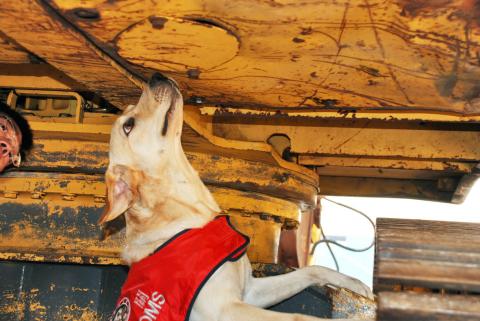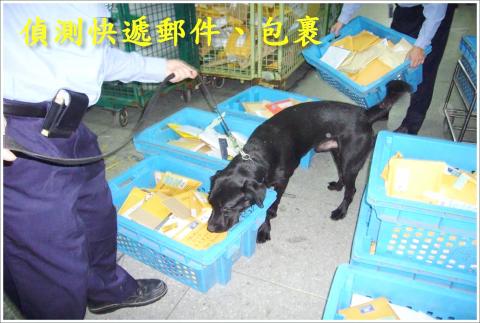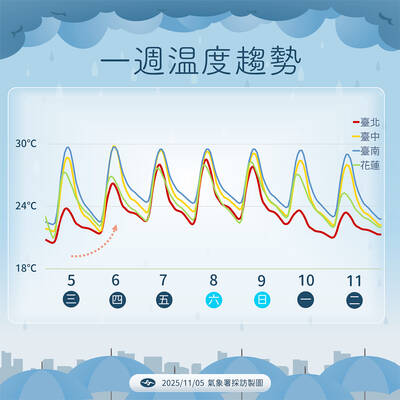While most Taiwanese have been relaxing with family and friends over the Lunar New Year holidays, the Department of Customs Administration — along with its 32 drug-detection dogs — have been working hard.
The idea of keeping a kennel of drug-detection dogs had been raised in 2001, but because of Taiwan’s uncertain position in the international community, unlike South Korea or Japan it could not count on the US or Australia for aid, Drug-Detection Dog Rearing Division member Lin Shih-chang (林世昌) said.
At first, civilian or academic organizations were contracted to help train dogs for drug detection, with customs receiving three between 2003 and 2006. Taiwan’s very first drug-detection dog was a Formosan mountain dog serving at the Taipei Customs Office for seven years before retiring in 2011, Lin said.

Photo courtesy of the department of Customs Administration
However, civilian training did not yield spectacular results, and it was not until the government accepted an offer from the Australian Customs Service to help with the training and a supply of dogs that the teams saw a significant improvement in performance, Lin said.
Australia supplied Taiwan with the training knowhow, as well as the dogs themselves — all Labrador retrievers. To date it has provided 47 canines at no additional expense. The going rate for an Australian drug-detection dog is about NT$530,000 (US$17,400).
The first puppy raised in Taiwan came into the world on June 2008 and since then, a further 180 Labradors have been bred from more than 30 litters.

Photo courtesy of the department of Customs Administration
Volunteer families were first asked to care for the pups, due to their need for human interaction, before starting training.
Drug-Detection Dog Training and Management Division head Chen Mu-sheng (陳木生) said that training takes 13 weeks per course for both the canines and their handlers, costing about NT$7,500 per dog.
Because barking and jumping might unnecessarily startle travelers, drug-detection dogs are trained from young not to bark, and instead of pouncing on suspects, they stand on their hind legs to sniff them, but do not touch, the administration said.

Photo courtesy of the department of Customs Administration
Giving treats as rewards is discouraged, Lin said, adding that training handlers usually toss them a towel and play with them instead.
It is also the reason the dogs are fed one meal per day, usually after they are off-duty, Lin said.
However, the average percentage of handlers who pass the training is 50 percent, while the success rate for the dogs stands at 23 percent.
Only 42 have completed training, and of the 32 currently on duty, 13 are based in Taipei, eight in Keelung, seven in Greater Kaohsiung and four in Greater Taichung, Chen said.
One of the obstacles is the handler’s stamina, Chen said.
Dogs have better stamina and these ones are very smart, Chen said, adding that if the handlers could not keep up with the dogs, the dogs did not respect or obey them.
With the low training success rate, housing dogs that did not pass the training became a problem, the administration said. At first, customs staff offered to adopt them, or they were adopted by the volunteer families who had cared for them before the training.
Later, the dogs were sent to other organizations, such as fire departments or disease control centers, or used to patrol forests, the administration said. The canines that were not adopted or given to organizations were put up for auction.
Though these dogs have not made it through the training, they are still government property, meaning certain procedures must be followed, the administration said.
The starting price at auctions is NT$500 to NT$800, the administration said, adding that customs is not short of money, and it was auctioning the dogs so that they could be placed with good families.
The administration keeps a list of the new owners and makes periodic checkups to ensure they are well cared for.
According to administration statistics, since the establishment of the training center in 2008, the amount of drugs seized has steadily risen.
Drug-detection dogs are usually on duty for eight hours a day, but handlers must not overwork them or else their sense of smell may tire, Lin said, adding that sniffer dogs should be given a break every 30 minutes, or at the least every hour.
Thanks to the dogs, 935kg of illegal drugs have been detected over the past year — estimated at nearly NT$3 billion (US$98.9 million) in market value — and the figure over the past five years rises to 1,578.8kg — or more than NT$3.9 billion, customs said.
There have been suggestions the administration has “padded” the figures of drugs detected, but officials say not all cases were a result of the dogs sniffing out drugs; in some cases, tip-offs were also received.
“The dogs work hard and have been through rigorous training. We hope the public can give them credit where credit is due for stopping drugs at our nation’s borders,” the administration said.

UNILATERAL MOVES: Officials have raised concerns that Beijing could try to exert economic control over Kinmen in a key development plan next year The Civil Aviation Administration (CAA) yesterday said that China has so far failed to provide any information about a new airport expected to open next year that is less than 10km from a Taiwanese airport, raising flight safety concerns. Xiamen Xiangan International Airport is only about 3km at its closest point from the islands in Kinmen County — the scene of on-off fighting during the Cold War — and construction work can be seen and heard clearly from the Taiwan side. In a written statement sent to Reuters, the CAA said that airports close to each other need detailed advanced

Tropical Storm Fung-Wong would likely strengthen into a typhoon later today as it continues moving westward across the Pacific before heading in Taiwan’s direction next week, the Central Weather Administration (CWA) said. As of 8am, Fung-Wong was about 2,190km east-southeast of Cape Oluanpi (鵝鑾鼻), Taiwan’s southernmost point, moving westward at 25kph and possibly accelerating to 31kph, CWA data showed. The tropical storm is currently over waters east of the Philippines and still far from Taiwan, CWA forecaster Tseng Chao-cheng (曾昭誠) said, adding that it could likely strengthen into a typhoon later in the day. It is forecast to reach the South China Sea

WEATHER Typhoon forming: CWA A tropical depression is expected to form into a typhoon as early as today, the Central Weather Administration (CWA) said yesterday, adding that the storm’s path remains uncertain. Before the weekend, it would move toward the Philippines, the agency said. Some time around Monday next week, it might reach a turning point, either veering north toward waters east of Taiwan or continuing westward across the Philippines, the CWA said. Meanwhile, the eye of Typhoon Kalmaegi was 1,310km south-southeast of Oluanpi (鵝鑾鼻), Taiwan’s southernmost point, as of 2am yesterday, it said. The storm is forecast to move through central

UNKNOWN TRAJECTORY: The storm could move in four possible directions, with the fourth option considered the most threatening to Taiwan, meteorologist Lin De-en said A soon-to-be-formed tropical storm east of the Philippines could begin affecting Taiwan on Wednesday next week, the Central Weather Administration (CWA) said yesterday. The storm, to be named Fung-wong (鳳凰), is forecast to approach Taiwan on Tuesday next week and could begin affecting the weather in Taiwan on Wednesday, CWA forecaster Huang En-hung (黃恩鴻) said, adding that its impact might be amplified by the combined effect with the northeast monsoon. As of 2pm yesterday, the system’s center was 2,800km southeast of Oluanbi (鵝鑾鼻). It was moving northwest at 18kph. Meteorologist Lin De-en (林得恩) on Facebook yesterday wrote that the would-be storm is surrounded by